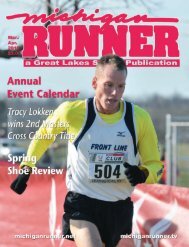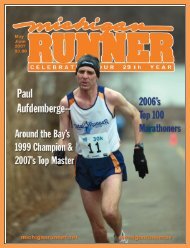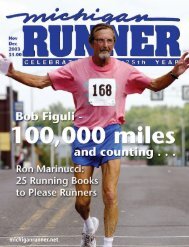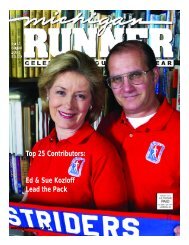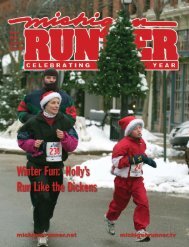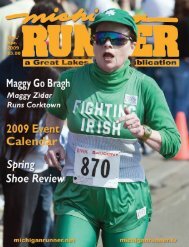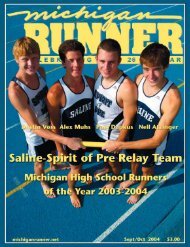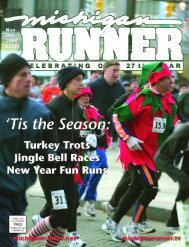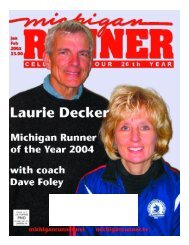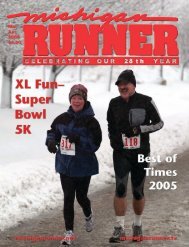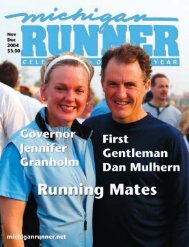You also want an ePaper? Increase the reach of your titles
YUMPU automatically turns print PDFs into web optimized ePapers that Google loves.
By Dr. Edward H. Kozloff<br />
Frank Shorter’s marathon<br />
victory at the 1972<br />
Olympic Games began an<br />
increased interest in marathoning<br />
throughout the United States.<br />
The 1976 Olympic Marathon<br />
caused even more enthusiasm<br />
and by 1977 over one hundred<br />
recognized marathons were held<br />
in the United States.<br />
That year, Detroit Free Press<br />
Sports Editor Joe Falls wrote<br />
what was perhaps at that time<br />
the most comprehensive and<br />
interesting book on the Boston<br />
Marathon. Two Motor City<br />
Strider members, Jerry Coyle and<br />
Bob Kiess, had each run over<br />
twenty marathons and were<br />
friends of Falls. They were<br />
instrumental in his becoming<br />
interested in the sport and are<br />
featured in one of the chapters of<br />
the book.<br />
At about this time, Neal<br />
Photo courtesy of Ed Kozloff<br />
Shine, Managing Editor of the<br />
Free Press, was visiting his<br />
brother in Cape Cod. During<br />
the visit, they watched the<br />
Falmouth Road Race and Shine<br />
returned home inspired with the<br />
idea that Detroit could host and<br />
support such an event.<br />
Early in 1978, Joe Falls was lured away<br />
to the Detroit News. Shine and Ladd<br />
Neumann, new sports editor, decided that<br />
Detroit was ready for a major marathon race.<br />
They were also aware that the city already<br />
held a marathon which was nationally<br />
respected by the running community and<br />
enjoyed a long history of success. The Motor<br />
City Marathon, first held in 1963, was the<br />
nation’s tenth oldest. <strong>In</strong> the 1966 race, Mike<br />
Hazilla, a student at Western <strong>Michigan</strong><br />
University, became only the third American<br />
to break 2:20 when he set a course record of<br />
2:18:47. Three years later, in 1969, Jerome<br />
Drayton, of Toronto, set a North American<br />
record of 2:12:00 on the Belle Isle course. <strong>In</strong><br />
1975, Ella Willis, a senior at Detroit’s<br />
Pershing High School, won the women’s race<br />
in 3:13:15 – one of the fastest times ever for<br />
a high school female. One year later, the race<br />
was awarded the Road <strong>Runner</strong> Club of<br />
America North Region Championship.<br />
<strong>In</strong> its fifteenth year, in 1977, the field<br />
nearly doubled to 428 entrants, making it<br />
one of the ten largest in the country. On a<br />
windy day with steady, mid-40°temperatures,<br />
Bob McOmber, of Bowling Green, Ohio, ran<br />
his first marathon and was first to the tape in<br />
2:23:37. Ann Forshee, of Wyandotte, set a<br />
women’s state record with a time of 2:55:59,<br />
placing her in the all-time top twenty-five<br />
performances for women in the country.<br />
There had never been a sponsor for the<br />
Motor City Marathon. All contacts, work,<br />
1997 Motor City Marathon, #343 John Gault, 32, Flushing, 3:13:18. Striped shirt behind<br />
him - Ann Forshee, 21,Wyandott, 2:55:59, 1st women, women's race & state record.<br />
and expenses had been handled by the<br />
Striders. The closest the club had ever come<br />
to receiving outside support was in the first<br />
years of the race, in 1963 and 1964 when<br />
club officials made contact with Marathon<br />
Oil of Ohio. However, after initial promises<br />
and several positive letters of correspondence,<br />
the deal fell through . . . All for a $50<br />
sponsorship! The leaders of the club at that<br />
time were quite disappointed and resented<br />
the oil company for several years thereafter.<br />
Early in 1978, the Striders were contacted<br />
by the Free Press and a meeting was held<br />
with Neal Shine, Ladd Neumann, and<br />
Strider club president Ed Kozloff. The Free<br />
Press representatives stated that they wanted<br />
to put a marathon race on the streets of<br />
Detroit and wanted it to be international in<br />
scope. The reputation of the Motor City<br />
Striders as well as that of the club’s Motor<br />
City Marathon assured them that the<br />
Striders would be the perfect partners for<br />
this venture. Kozloff would remain the race<br />
director (which would be his fourth year in<br />
that position) and Molly Anderson of the<br />
Free Press would be the race coordinator.<br />
The original plan was to start the race<br />
on Belle Isle, run to downtown Detroit, and<br />
then through the Detroit-Windsor Tunnel.<br />
The race would continue in Windsor to the<br />
Ambassador Bridge, which would be about<br />
seventeen miles into the race and would be<br />
Detroit’s version of “Heartbreak Hill.” The<br />
route would then return to the finish on<br />
Belle Isle.<br />
Authorities at both the tunnel and<br />
“Run the inland sea”<br />
Grosse Pointe Run<br />
Saturday, September 15, 2007<br />
Grosse Pointe Farms Municipal Pier<br />
at Moross and Lake Shore Road<br />
5K & 10K runs • 5K competitive<br />
walk • 5K wheelchair- 9:00 am<br />
1 Mile fun run - 8:30 am<br />
Registration is from 7:00-8:30 am<br />
** 5 & 10K runs - USATF Certified **<br />
Organized by<br />
Grosse Pointe<br />
Rotary Sunrise Club<br />
Register online: active.com<br />
800-299-5007<br />
M I C H I G A N R U N N E R<br />
15<br />
1



